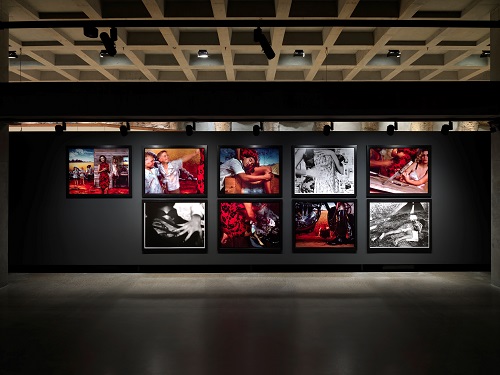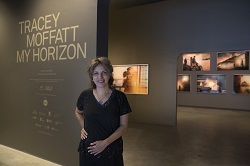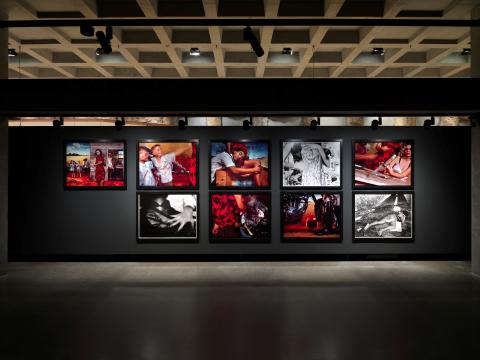SOMETHING MORE NO. 1, 1989
TRACEY MOFFATT
Cibachrome print
82.0 x 104.0 cm
artist proof, apart from an edition of 30
Collection of the Artist
Private collection, Sydney
Phillips De Pury & Company, Sydney, 30 July 2001, lot 126
Gordon Darling AC, Melbourne
Private collection, Melbourne
(Selected) Other examples of this image have been exhibited and published widely including:
Something More, Australian Centre for Photography, Sydney, and touring through regional galleries, 1989
Tracey Moffatt, Institute of Modern Art, Brisbane and Asia Link, Melbourne, 1990 (illus. in exhibition catalogue, p. 55)
Tracey Moffatt, Kunsthalle Wien, Vienna, 10 April – 7 June 1998 and travelling throughout Europe (illus. in exhibition catalogue, p. 55)
Tracey Moffatt, Nassau County Museum of Art, New York, February – April 2001
Tracey Moffatt, City Gallery Wellington, Wellington, 1 February – 26 May 2002 (illus. in exhibition catalogue, p. 26)
Tracey Moffatt, Museum of Contemporary Art, Sydney, 17 December – 29 February 2004
Tracey Moffatt. Between Dreams and Reality, Spazio Oberdan, Milan, 28 June – 1 October 2006 (illus. in exhibition catalogue, p. 120)
Newton, G., Tracey Moffatt: Fever Pitch, Piper Press, Sydney, 1995, pp. 13, 16, 17 (illus.), 39 (illus., another example)
Martin, A., 'Tracey Moffatt's Australia (A Reconnaissance)', Parkett, no .53, 1998, p. 23 (illus. another example)
Reinhardt, B. et al., Tracey Moffatt: Laudanum, Hatje Cantze, Germany, 1999, p. 10 (illus., another example)
Travis, L., ‘Mirage: Drysdale and Moffatt in the Australian Outback’, Art and Australia, Fine Arts Press, Sydney, 2000, vol. 37, no. 4, pp. 548 – 555 (illus. p. 552, another example)
Summerhayes, C., The Moving Images of Tracey Moffatt, Edizioni Charta, Milan, 2007, pp. 15 (illus., another example)
Other examples of this edition are held in the collections of the National Gallery of Australia, Canberra, Museum of Contemporary Art, Sydney, Art Gallery of New South Wales, Sydney, Murray Art Museum Albury, Albury-Wodonga, and the Artbank Collection, Sydney.
Something More suite.jpg

Installation photograph featuring SOMETHING MORE No. 1
(top left image) in
TRACEY MOFFATT
Something More, 1989
the full series of nine Cibachrome prints
Collection MONA Museum of Old and New Art, Hobart
photograph by Rémi Chauvin
courtesy of MONA Museum of Old and New Art, Hobart
© reproduced with the permission of VISCOPY Ltd
and Roslyn Oxley9 Gallery
The scene set with a painted backdrop evoking the ubiquitous and prosaic Australian back verandah, the opening frame of Tracey Moffatt’s acclaimed photographic series Something More presents the artist herself as the protagonist of a tawdry melodrama. The carefully constructed, rich, staged tableaux of Moffatt’s works transcend simple photographic practice, melding with classical iconography and the popular, time-based medium of cinematography. Tracey Moffatt is a contemporary storyteller who uses photography and film to create a narrative and a social commentary, derived from her personal memory, classic tropes of Hollywood film, current affairs, and history itself. Moffatt is a part of a generation of photographic artists in the 1980s who subverted the camera’s claim to naturalism, creating works that were fanciful and sometimes entirely incompatible with reality (such as Jeff Wall, Cindy Sherman, and Yasumasa Morimura).
Something More No. 1, 1989 is the first photograph in a suite of nine Cibachrome prints, forming storyboards like film stills that create a storyline of a young woman hoping in vain to escape both her humble beginnings and destiny. This modern Australian adaptation of the story of the Fallen Woman is one told with sensitivity, wry humour, and a strong identification between the artist and her flawed heroine. Cinematic effect is central to the power of Moffatt’s work, as is the plethora of highly-informed visual references. Created in 1989, this series quickly won her international acclaim and was exhibited extensively throughout the world, becoming the subject of many a lively literary analysis. For the emerging artist, 1989 was a watershed year, with her short film Night Cries also being screened at the Cannes Festival. For Moffatt, 2017 is an even more momentous year, having been chosen to represent Australia in the 57th International Art Exhibition at the Venice Biennale.
Moffatt at Venice.jpg

AUSTRALIAN PAVILION,
VENICE BIENNALE, 2017
While the complex web of artistic references, iconography and popular visual culture is too rich to address within the scope of this essay, it should not be discounted in the appreciation of this work. It enables the artist to transcend the physical limits of her photographic print, creating instead an image that is inscribed within time and whose narrative is open-ended. Each frame distils a scene, containing as much visual information as possible to carry the storyline across only nine frames. Gael Newtown writes of the complex composition of this first frame of the series, noting that it is constructed according to the codes of Medieval altarpieces, each character inhabiting a panel of the polyptych.3 Something More No. 1 is undoubtedly the most iconic image of the series. It captures not only a scene, but condenses the entire narrative into one frame. It is also the most hopeful image of the series – featuring the artist centre stage, inhabiting a theatrical space between the spheres of private experience and public performance, the multiple endings of her story all still possible.
Combining the depression-era squalor of Russell Drysdale’s 1942 painting Back Verandah, with the sultry glamour of Hollywood, Moffatt herself plays the role of hopeful starlet in a tattered red and black cheongsam, wide-eyed and taking a step forward towards an unknown future. The wistful expression on her face is central to Moffatt’s message and artistic practice. Catherine Summerhayes notes in her 2007 survey of Moffatt’s cinematic practice that this look is pervasive throughout Moffatt’s oeuvre – ‘Moffatt looks out beyond the foreground of her visual frames; she is looking for “something more” than the immediately obvious. Her searching gaze is directed outwards at what being in the world means.’1
1. Summerhayes, C., The Moving Images of Tracey Moffatt, Edizioni Charta, Milan, 2007, p. 16
LUCIE REEVES-SMITH

